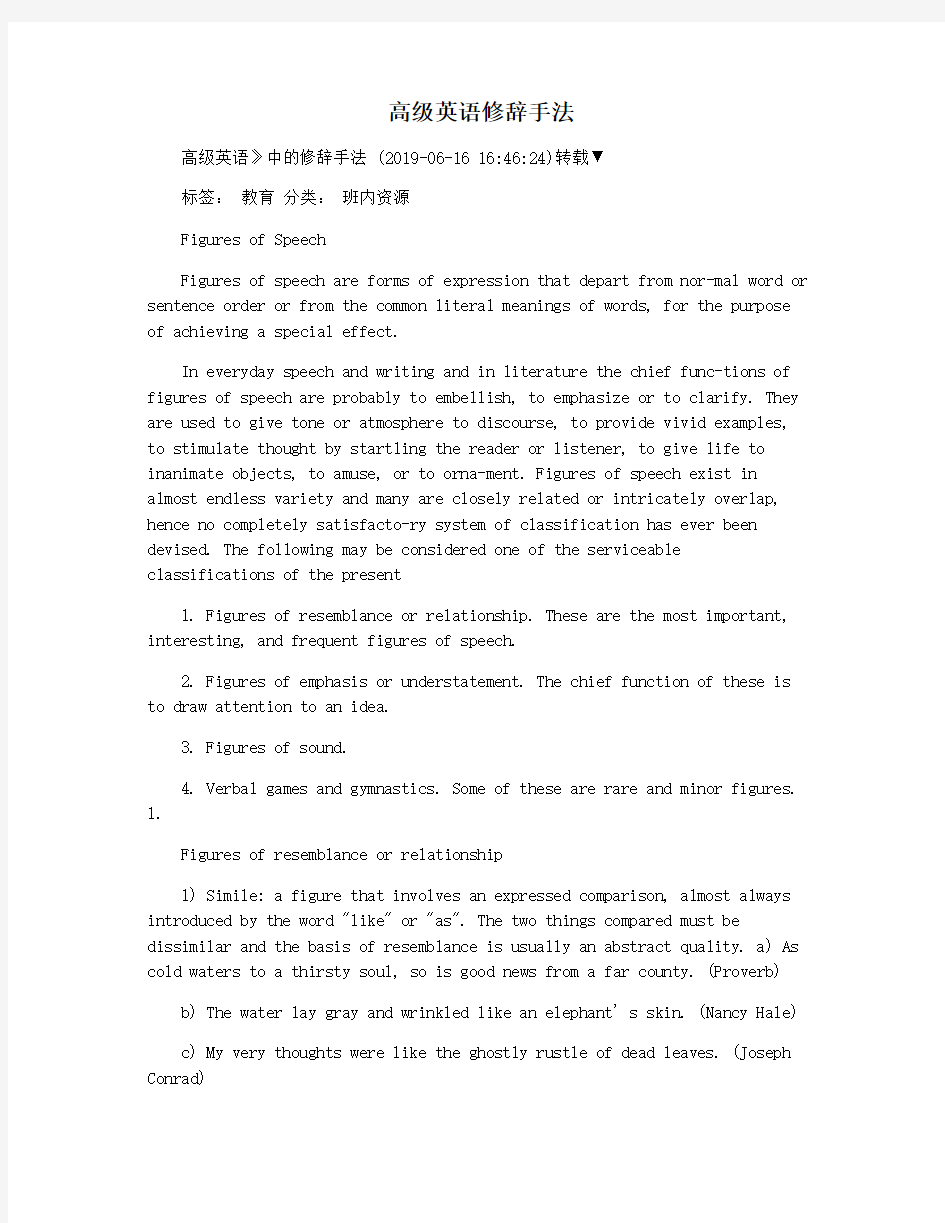高级英语修辞手法

- 1、下载文档前请自行甄别文档内容的完整性,平台不提供额外的编辑、内容补充、找答案等附加服务。
- 2、"仅部分预览"的文档,不可在线预览部分如存在完整性等问题,可反馈申请退款(可完整预览的文档不适用该条件!)。
- 3、如文档侵犯您的权益,请联系客服反馈,我们会尽快为您处理(人工客服工作时间:9:00-18:30)。
高级英语修辞手法
高级英语》中的修辞手法 (2019-06-16 16:46:24)转载▼
标签:教育分类:班内资源
Figures of Speech
Figures of speech are forms of expression that depart from nor-mal word or sentence order or from the common literal meanings of words, for the purpose of achieving a special effect.
In everyday speech and writing and in literature the chief func-tions of figures of speech are probably to embellish, to emphasize or to clarify. They are used to give tone or atmosphere to discourse, to provide vivid examples, to stimulate thought by startling the reader or listener, to give life to inanimate objects, to amuse, or to orna-ment. Figures of speech exist in almost endless variety and many are closely related or intricately overlap, hence no completely satisfacto-ry system of classification has ever been devised. The following may be considered one of the serviceable
classifications of the present
1. Figures of resemblance or relationship. These are the most important, interesting, and frequent figures of speech.
2. Figures of emphasis or understatement. The chief function of these is to draw attention to an idea.
3. Figures of sound.
4. Verbal games and gymnastics. Some of these are rare and minor figures. 1.
Figures of resemblance or relationship
1) Simile: a figure that involves an expressed comparison, almost always introduced by the word "like" or "as". The two things compared must be dissimilar and the basis of resemblance is usually an abstract quality. a) As cold waters to a thirsty soul, so is good news from a far county. (Proverb)
b) The water lay gray and wrinkled like an elephant' s skin. (Nancy Hale)
c) My very thoughts were like the ghostly rustle of dead leaves. (Joseph Conrad)
2) Metaphor: The substitution of one thing for another, or the
identification of two things from different ranges of thought. It is often loosely defined as "an implied compari-son," "a simile without 'like' or 'as'". Metaphor is con-sidered by many the most important and basic poetic figure and also the commonest and the most beautiful. a) Boys and girls, tumbling in the streets and playing, were moving jewels.
b) The town was stormed after a long siege.
c) Snow clothes the ground.
d) He swam bravely against the tide of popular applause. A note of warning:
Avoid mixing figures of speech.
a) This is not the time to throw up the sponge, when the enemy, already weakened and divided, are on the run to a new defensive position, (mixed metaphor; a mixture of prize—ring and battlefield)
b) There is every indication that Nigeria will be a tower of strength and will forge ahead, (mixed metaphor; a mixture of a fortress and a ship)
3) Personification: a figure that endows objects, animals, ideas, or abstractions with human form, character, or sen-sibility. There are three
chief kinds of personifications:
a) That produced by the use of adjectives.
the blushing rose! the thirsty ground
b) That produced by the use of verbs.
the kettle sings; the waves danced
c) That produced by the use of nouns.
the smiles of spring! the whisper of leaves
4) Metonymy: the substitution of the name of one thing for that of another with which it is closely associated. a) The pen is mightier than the sword. (Here you have the instrument (pen or sword) as a name for the people wielding it.)
b) Gray hairs should be respected, (the symbol (gray hair) as a name for
the persons (old people) symbolized) c) He is too fond of the bottle. ( = He
